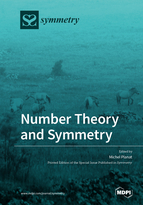Number Theory and Symmetry
A special issue of Symmetry (ISSN 2073-8994). This special issue belongs to the section "Mathematics".
Deadline for manuscript submissions: closed (31 January 2020) | Viewed by 32472
Special Issue Editor
Interests: topological quantum computing; epigenetics and epitranscriptomics; signal processing; geometry; quantum mechanics; discrete mathematics; graph theory; group theory; structural stability; communication; pure mathematics; topology
Special Issues, Collections and Topics in MDPI journals
Special Issue Information
Dear Colleagues,
This Special Issue, “Number Theory and Symmetry” deals with all topics connecting numbers (integers, algebraic integers) and symmetries. First of all, symmetry entered number theory when Riemann investigated the distribution of prime numbers and for that purpose introduced the complex functional equation and the related Riemann hypothesis (RH) that non-trivial zeros of the Riemann zeta function lie on the symmetry axis s=1/2. Then, in a quest to justify RH on physical grounds, the Hilbert-Polya conjecture claimed that the imaginary part of the Riemann zeros on the symmetry axis should correspond to the eigenvalues of a Hermitian operator. It may be that a pseudo-Hermitian operator with parity-time (PT) symmetry would be more appropriate, according to recent work. Besides these classical areas, number fields offer clues to the connection between numbers and symmetries through arithmetic Kleinian groups, geometry and topology. I have in mind the Poincaré conjecture and the whole work of Thurston about 3-manifolds.
Prof. Michel Planat
Guest Editor
Manuscript Submission Information
Manuscripts should be submitted online at www.mdpi.com by registering and logging in to this website. Once you are registered, click here to go to the submission form. Manuscripts can be submitted until the deadline. All submissions that pass pre-check are peer-reviewed. Accepted papers will be published continuously in the journal (as soon as accepted) and will be listed together on the special issue website. Research articles, review articles as well as short communications are invited. For planned papers, a title and short abstract (about 100 words) can be sent to the Editorial Office for announcement on this website.
Submitted manuscripts should not have been published previously, nor be under consideration for publication elsewhere (except conference proceedings papers). All manuscripts are thoroughly refereed through a single-blind peer-review process. A guide for authors and other relevant information for submission of manuscripts is available on the Instructions for Authors page. Symmetry is an international peer-reviewed open access monthly journal published by MDPI.
Please visit the Instructions for Authors page before submitting a manuscript. The Article Processing Charge (APC) for publication in this open access journal is 2400 CHF (Swiss Francs). Submitted papers should be well formatted and use good English. Authors may use MDPI's English editing service prior to publication or during author revisions.
Keywords
- Number theory
- Hilbert-Polya conjecture
- 3-manifolds and quaternion algebras
- Modular functions and Langlands program
- Galois theory
- Quasicrystals
- Quantum physics






